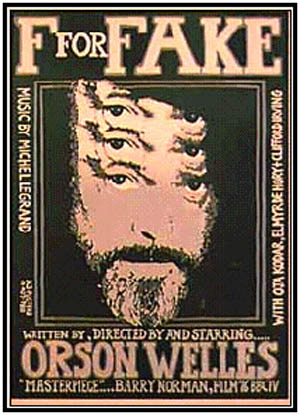- F for Fake
Infobox Film
name = F for Fake

image_size =
caption =
director =Orson Welles
producer =François Reichenbach
Dominique Antoine
Richard Drewitt
writer = Orson WellesOja Kodar
narrator =
starring = Orson Welles
Oja KodarJoseph Cotten Elmyr de Hory Clifford Irving
François ReichenbachGary Graver
music =Michel Legrand
cinematography = François Reichenbach
editing = Marie-Sophie Dubus
Dominique Engerer
distributor = flagicon|USA Specialty Films
released = flagicon|USASeptember 25 ,1975
runtime = 85 min
country =France /Iran / West Germany
language = English / French / Spanish
budget =
preceded_by =
followed_by =
website =
amg_id = 1:125386
imdb_id = 0072962"F for Fake" ( _fr. Vérités et Mensonges) is the last major film completed by
Orson Welles . Initially released in 1974, it focuses on Elmyr de Hory's recounting of his career as a professionalart forger ; de Hory's story serves as the backdrop for a fast-paced, meandering investigation of the natures of authorship and authenticity, as well as the basis of the value of art.Far from serving as a traditional documentary on
Elmyr de Hory , the film also incorporates Welles's companionOja Kodar , notorious "hoax-biographer"Clifford Irving , and Orson Welles himself, in an autobiographical role. In 2005The Criterion Collection released the film onDVD .Synopsis
Several narratives are woven together throughout the film, including those of de Hory, Irving, Welles, and Kodar.
About de Hory, we learn that he was a struggling artist who turned to forgery out of desperation, only to see the greater share of the profits from his deceptions go to doubly-unscrupulous art dealers. As partial compensation for that injustice he is maintained in a villa in Ibiza by one of his dealers. What is only hinted at in Welles's documentary is that de Hory had recently served a two-month sentence in a Spanish prison for homosexuality and consorting with criminals. (De Hory would commit suicide a few years after the release of Welles's film, on hearing that Spain had agreed to turn him over to the French authorities.)
Irving's original part in "F for Fake" was as de Hory's biographer, but his part grew unexpectedly at some point during production. There has not always been agreement among commentators over just how that production unfolded, but the now-accepted story [http://www.thewag.net/film/f_for_fake.html] is that the director François Reichenbach shot a documentary about de Hory and Irving before giving his footage to Welles, who then shot additional footage with Reichenbach as his cinematographer. In the time between the shooting of Reichenbach's documentary and the finishing of Welles's, it became known that Irving had perpetrated a hoax of his own, namely a fabricated "authorized biography" of
Howard Hughes (the hoax was later dramatized — some say fictionalized — in "The Hoax "). This discovery prompted the shooting of still more footage, which then got woven into "F for Fake".Exactly one hour before narrating Kodar's story, Welles promises that everything in the next hour of his film will be true. By the time of Kodar's story the viewer has naturally forgotten the letter of Welles's promise — and gets duped. The clever yarn has Kodar sitting for
Pablo Picasso after getting him to agree to give her the finished portraits, and then selling not those very portraits but fake Picassos in their place. In the commentary to the Criterion Collection DVD release of "F for Fake", Kodar claims the idea for this segment as her own. She also claims credit for the movie's opening sequence, which consists of shots of Kodar walking down French streets while rubbernecking male admirers stop and openly stare — all the while being surreptitiously filmed, according to the narration. This sequence is described by Kodar as inspired by her feminism.Reception
"F for Fake" faced widespread popular rejection in the director's home country upon its release, though it fared better commercially in Europe. Fact|date=April 2008 Critical reaction ranged from praise to confusion and hostility, with many finding the work to be indulgent or incoherent. Fact|date=April 2008 "F for Fake" has, however, grown in stature over the years and is now often considered not only a film classic, but a precursor to modern editing techniques as well as a popularizer of more avant-garde methods. Fact|date=June 2008 As the film embraces everything from self-conscious notation of the film process, to ironic employment of '50s-era
B-movie footage, Welles in essence was creating not so much a documentary as a "new kind of film," as he once told writerJonathan Rosenbaum . Fact|date=June 2008tyle
"F for Fake" is often judged a masterpiece of the art of editing [http://newyorkreview.org/mag/index.php?option=com_content&task=view&id=272&Itemid=38] — a key subject of the film itself, which at many points shows Welles sitting at his editing desk as he narrates. Welles and his assistants worked on the final cut for an entire year — shots are rapidly intercut almost by the second throughout, lending the film a quick-paced touch. One of the examples considered to be among the best is a series of near-wordless shots of Irving and de Hory seemingly in debate as to whether de Hory ever signed his forgeries (the shots of Irving and de Hory were in fact taken at different times).
Welles's autobiographical asides in the film reflect on his 1938 radio adaptation of "The War of the Worlds", which caused a nationwide panic with its fake news broadcast. In introducing this chapter of his life, Welles declares his uncertainty as to his own authenticity, as he believes he too has engaged in fraud.
ee also
*"
My Kid Could Paint That "External links
* [http://youtube.com/watch?v=ksmjh8LL2zA Welles' "Chartres" monologue]
*
* [http://movies2.nytimes.com/mem/movies/review.html?_r=1&res=9A00EEDE123AE333A2575BC2A96F9C946490D6CF 'F for Fake' Is an Illusionist's Trick With Bogus Heroes and Expert Villains] by Vincent Canby, New York Times, September 28, 1975
* [http://www.brightlightsfilm.com/45/fake.htm F for Fake: The Ultimate Mirror of Orson Welles] article by Robert Castle, August 2004.
Wikimedia Foundation. 2010.
